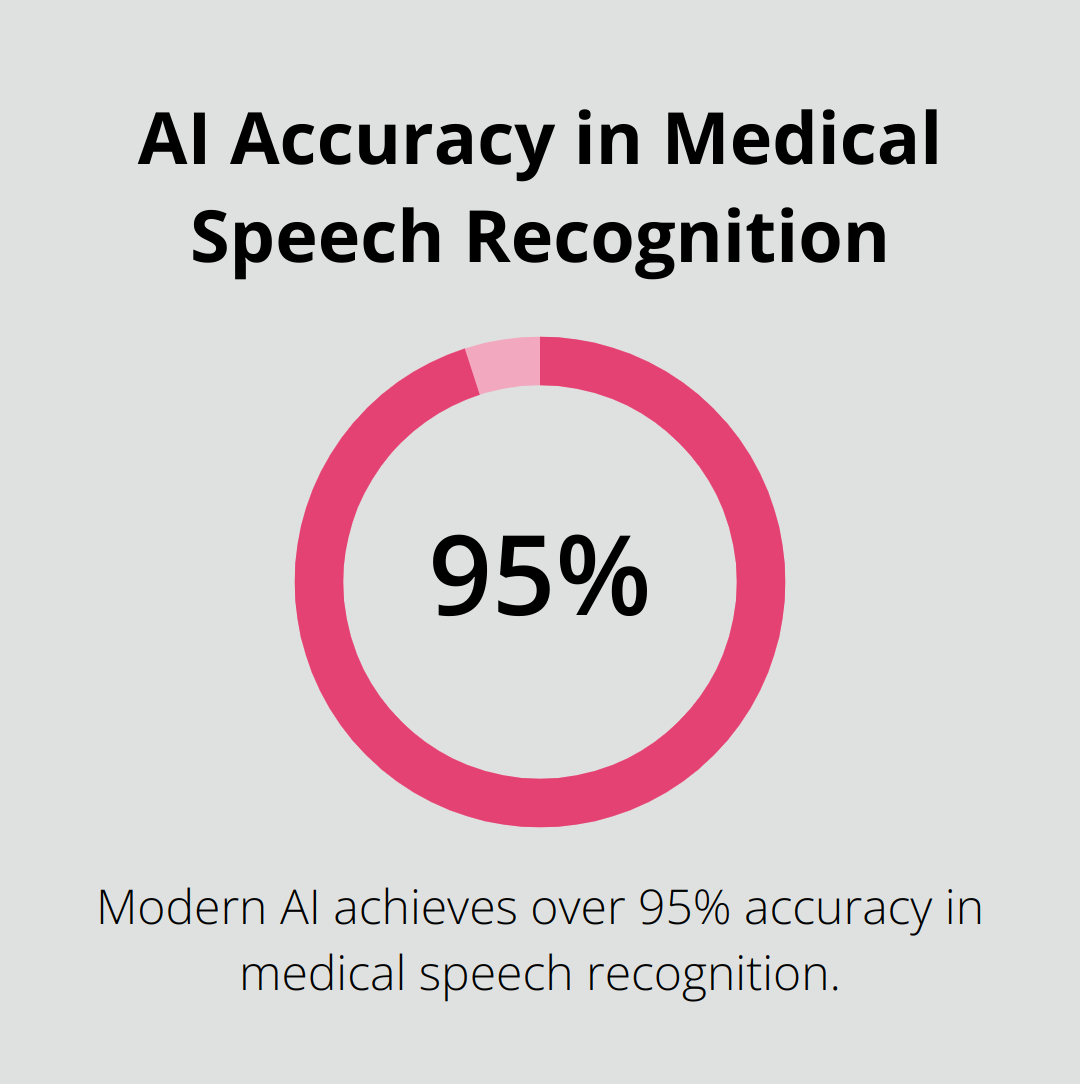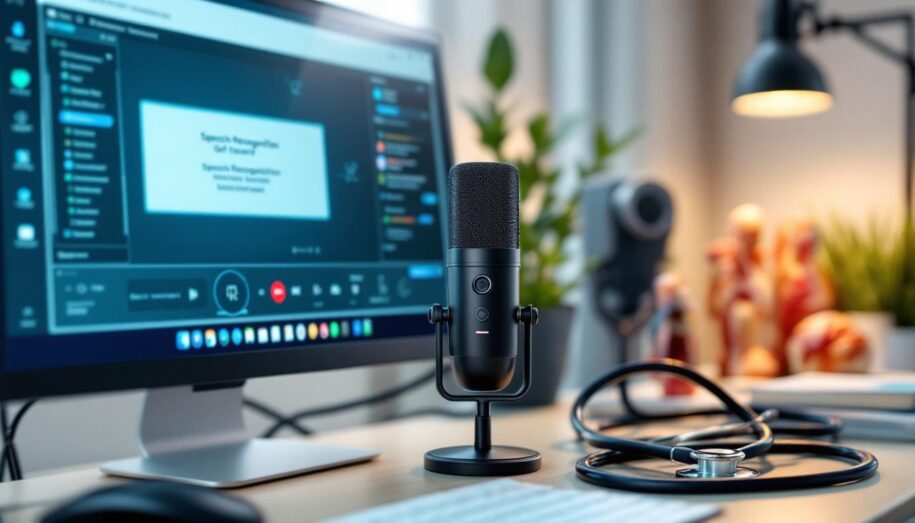Speech recognition tech … in healthcare? It’s shaking things up, folks. Nurses, doctors — the whole medical crew — now have a shiny new tool that promises to simplify the mess of paperwork and actually let them care about patients (imagine that). The wizards at ScriberJoy are already witnessing the magic — cutting down doc times and ramping up record accuracy.
So, where are we headed? The future, my friends, is all about getting cozy with speech recognition. It’s no longer a choice; it’s the secret sauce for healthcare pros aiming to turbocharge their efficiency and, you know, actually chat with their patients. This little guide here? It’s your roadmap to mastering speech recognition in the medical world, with the added bonus of dodging the usual headaches along the way.
What Is Speech Recognition in Healthcare?
Alright, so here’s the skinny: speech recognition in healthcare – it’s all about turning the babble of doctors and nurses into text magic. You know, letting them talk their way into those electronic health records (EHRs) without wrestling with a keyboard. Essentially, it’s a game-changer for documentation.
The Evolution of Medical Speech Recognition
We’ve come a long way, baby. Early attempts at this tech were like teaching your dog to say “I love you.” Cute, but didn’t quite get the message across, especially with medical lingo and accents muddling things up. Flash forward to today – AI’s got it together, pulling off accuracy that’s north of 95%… it’s like we’ve gone from dial-up to fiber optic in the med world. Mind-blowing stats right here.

How Speech Recognition Works in Practice
So, picture this: a doctor chats into a mic. The software catches those sound waves, flips ’em into ones and zeros, and bam – complex algorithms do their thing, hooking up sounds with the right words. It’s like the software’s got its PhD in medical chatter, all trained up on the vocab so it knows the difference between a ‘humerus’ and a ‘funny bone’.
The Impact on Healthcare Efficiency
This stuff is shaking up how health folks do their job. Clinicians jumping on the speech recognition train are saving time like you wouldn’t believe. More than 90% are living proof that swapping pen-and-paper for mic-and-tech boosts note quality and lets ’em keep their eyes on the prize – patients.

Improving Patient Care Through Better Documentation
At the heart of it, stellar documentation equals top-notch patient care. With this speech recognition wizardry, docs are crafting detailed patient narratives on the fly. The upshot? Smarter decision-making, leading to better outcomes for the folks they’re caring for.
As we roll ahead, wrapping our minds around speech recognition’s role in healthcare is crucial. Next up: diving into choosing the right software, nailing the training for medical transcription, and smoothly slotting it in with those EHR systems. Keep your eyes peeled!
How to Implement Speech Recognition in Your Medical Practice
Speech recognition is shaking up medical workflows like never before. This chapter dives into the essentials of getting this tech buzzing in your practice.
Selecting the Right Software
Speech recognition software-it’s not a one-size-fits-all game. Dragon Medical One usually takes the crown among clinicians, aiming to make documentation a breeze with smart support all around you. But hey, don’t overlook ScribeJoy (our top pick)-it’s like AI and humans teaming up, nailing over 99% accuracy.
Let’s be real-price matters, but it’s not the whole story. You gotta find software that speaks your specialty language. A radiologist? Pediatrician? Different vocabularies, folks. Ensure it meshes well with your current systems to dodge future headaches.
Customizing Medical Terminology
AI’s gotta speak your language-doctor-speak, that is. Most setups come equipped with medical dictionaries, but let’s be clear, customization is king. Add those terms, acronyms, and patient names you’re always saying.
How about some custom macros? Why keep saying, “patient denies chest pain, shortness of breath, or palpitations,” when “negative cardiac review” can pop it in? Time saved-a lot.
Integrating with EHR Systems
Voice input technology is a game-changer for EHR work. It streamlines the documentation process like magic.
Some EHR vendors serve up their own speech recognition goodies. Take Epic’s NoteWriter-voice commands to steer through the EHR. Handy, sure, but often these built-ins miss the bells and whistles that standalone software boasts.
Piloting the Program
Implementation-it’s a journey, not a pit stop. Kick off with a pilot program in one department before unleashing it everywhere. This way, you can tackle issues head-on and get the staff on board.
Never underestimate training power. A Journal of the American Medical Informatics Association study shows just 30 minutes of targeted training boosts accuracy from 90% to 98% (not bad for a little time sink).

As you cruise into speech recognition territory, you’ll hit some bumps. Next chapter’s got you covered with tackling those hurdles and offers strategies for a smooth ride with this game-changing technology.
Tackling Speech Recognition Hurdles in Healthcare
Accent and Noise: The Twin Terrors
Accents and background noise – the stuff of nightmares for speech recognition. Speech recognition errors occur commonly, with annunciation errors leading the pack. Big shocker – error rates were comparable if not lower than past studies.
So, how do we fix this? Easy peasy (kinda): healthcare providers should drop some cash on top-notch, noise-canceling microphones. The Philips SpeechMike Premium? It slices background noise by up to 60%. Quiet zones for dictation are like magic potions for better results.
Accents? No problemo. Modern software’s got your back with accent training. Users of Dragon Medical One boast a 20% accuracy bump after just a couple hours of personal training. Bingo.
Keeping Patient Data Secure
Data security in healthcare? Priority numero uno. HIPAA violations can bring down the hammer with hefty fines and legal headaches. Penalties – they come tiered based on just how badly you screw up.
Choosing software? Go with end-to-end encryption and SOC 2 Type II certification. ScribeJoy offers all that jazz, plus HIPAA-compliant cloud storage. Safe bet.
Edu-training staff on data protection is key. The Office for Civil Rights drops the bomb: 58% of HIPAA violations stem from oopsies within your own walls. Regular training? It cuts risks big time.
Accuracy: A Critical Factor
Accuracy in medical documentation – kinda a big freakin’ deal. A single decimal gone rogue in medication dosage? Catastrophic.
Most speech software brags about 95% accuracy fresh out of the box. Medical pros should aim higher – like, 99%+. That’s where human verification steps in. ScribeJoy’s hybrid AI-human tango dances past 99% accuracy.
Healthcare pros, get your error-checking game on. Transcriptionists or medical scribes should peek at AI-generated notes. Hey, a study in the Journal of AHIMA says this two-step process shrinks errors by up to 80%.
Keep that software updated regularly. Vendors release updates that boost performance. Automatic updates? Yeah, they lift accuracy by 2-3% each year without you lifting a finger. Sweet deal.
Final Thoughts
Speech recognition tech is shaking up healthcare documentation… big time. It’s slashing those annoying admin tasks and boosting accuracy-freeing up medical pros to do what they do best: care for patients. We’ve journeyed from those clunky, error-prone systems of yesteryear to slick, AI-powered solutions hitting accuracy rates north of 95%. That’s some serious progress.
What’s next? Well, the future of speech recognition in healthcare ain’t holding back. We’re talking improved natural language processing, maybe even augmented reality for hands-free interfaces-imagine that. All this will kick workflow efficiency and patient care quality up several notches.
If you’re in the medical field and haven’t jumped on this yet, what are you waiting for? ScribeJoy has you covered, offering a solid combo of AI transcription and human checks (yep, over 99% accuracy). With tweakable templates and HIPAA compliance, ScribeJoy shows how speech recognition can totally transform medical documentation.

Leave a Reply
You must be logged in to post a comment.